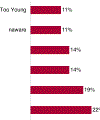Caregiver Comfort in Adolescents Independently Completing Screening Tablet-Based Questionnaires at Primary Care Visits
- PMID: 31522906
- PMCID: PMC7358079
- DOI: 10.1016/j.jadohealth.2019.07.008
Caregiver Comfort in Adolescents Independently Completing Screening Tablet-Based Questionnaires at Primary Care Visits
Abstract
Purpose: The objective of this study was to assess caregiver comfort regarding adolescent completion of computerized health screening questionnaires created for adolescents.
Methods: We conducted a mixed-method, cross-sectional survey of caregivers of adolescent patients (n = 104) aged 12-18 years who had a medical visit between June 2017 and August 2017. Topics assessed included who completed the questionnaire, caregiver comfort and concern regarding questionnaire data, and caregiver reasons for involvement in completing the questionnaire. A one-way analysis of variance was used to compare the age of the adolescent and caregiver involvement in the questionnaire.
Results: The majority of adolescents (64%) reported independent completion of the questionnaire. Thirteen percent of caregivers completed the questionnaire with no involvement of the adolescent and 23% reported that caregivers and adolescents completed the questionnaire in tandem. The majority of caregivers (84%) were comfortable with adolescents completing the questionnaire. A variety of reasons were identified for caregivers completing the questionnaire (time constraints, 22%; adolescent requested caregiver help, 19%; caregiver desired to answer questions, 14%; caregiver did not realize that the questionnaire was intended for the adolescent, 11%; caregiver believed that the adolescent was too young to respond alone, 11%). Caregiver comfort with adolescent completing the questionnaire increase with age.
Conclusion: We found the reason most caregivers gave for completing the questionnaires were related to clinic processes (e.g. time constraints). Caregivers were more likely to complete the questionnaire with younger adolescents. Thus, pediatricians should consider how to best prepare families for initial questionnaires in primary care.
Keywords: Adolescent; Caregiver; Primary care; Screening.
Copyright © 2019 Society for Adolescent Health and Medicine. Published by Elsevier Inc. All rights reserved.
Figures
Similar articles
-
Level and comfort of caregiver-young adolescent communication on sexual and reproductive health: a cross-sectional survey in south-western Uganda.BMC Public Health. 2022 Nov 19;22(1):2129. doi: 10.1186/s12889-022-14561-3. BMC Public Health. 2022. PMID: 36403003 Free PMC article.
-
[Factors related to the passive attitude of caregivers on dental care visit when elementary and junior high school children are diagnosed with dental caries].Nihon Koshu Eisei Zasshi. 2020;67(4):283-294. doi: 10.11236/jph.67.4_283. Nihon Koshu Eisei Zasshi. 2020. PMID: 32389927 Japanese.
-
Food for Thought: A Randomized Trial of Food Insecurity Screening in the Emergency Department.Acad Pediatr. 2019 Aug;19(6):646-651. doi: 10.1016/j.acap.2018.11.014. Epub 2019 Jan 11. Acad Pediatr. 2019. PMID: 30639763 Free PMC article. Clinical Trial.
-
The Caregiver Perspective on Unscheduled 72-Hour Return Visits to Pediatric Acute Care Sites: A Focus on Discharge Processes.Acad Pediatr. 2017 Sep-Oct;17(7):755-761. doi: 10.1016/j.acap.2017.02.003. Epub 2017 Feb 12. Acad Pediatr. 2017. PMID: 28215655
-
[Caregiver burden in relatives of persons with schizophrenia: an overview of measure instruments].Encephale. 2003 Mar-Apr;29(2):137-47. Encephale. 2003. PMID: 14567165 Review. French.
Cited by
-
Perceived Facilitators of and Barriers to Implementation of a Decision Support Tool for Adolescent Depression and Suicidality Screening: Focus Group and Interview Study.JMIR Ment Health. 2021 Sep 15;8(9):e26035. doi: 10.2196/26035. JMIR Ment Health. 2021. PMID: 34524090 Free PMC article.
-
Effects and Satisfaction of Comfort Nursing plus Psychological Nursing in the Clinical Nursing of Neurology Patients: A Comparative Study.Evid Based Complement Alternat Med. 2022 May 25;2022:8013787. doi: 10.1155/2022/8013787. eCollection 2022. Evid Based Complement Alternat Med. 2022. Retraction in: Evid Based Complement Alternat Med. 2023 Jun 21;2023:9801470. doi: 10.1155/2023/9801470. PMID: 35664947 Free PMC article. Retracted.
References
-
- Rosen DS, Elster A, Hedberg V, Paperny D. Clinical preventive services for adolescents: position paper of the Society for Adolescent Medicine. Journal of Adolescent Health. 1997;21(3):203–214. - PubMed
-
- Ozer EM, Brindis CD, Millstein SG, Knopf DK, Irwin CE. America’s adolescents: Are they healthy. San Francisco: University of California, School of Medicine; 1998.
-
- Elster AB, Levenberg P. Integrating comprehensive adolescent preventive services into routine medicine care. Rationale and approaches. Pediatr Clin North Am. 1997;44(6):1365–1377. - PubMed
-
- Statistics CNCfH. Adolescent Health FastStats. 2017; https://www.cdc.gov/nchs/fastats/adolescent-health.htm Accessed January 4th, 2018.
-
- Coker TR, Sareen HG, Chung PJ, Kennedy DP, Weidmer BA, Schuster MA. Improving access to and utilization of adolescent preventive health care: the perspectives of adolescents and parents. Journal of Adolescent Health. 2010;47(2):133–142. - PubMed
Publication types
MeSH terms
Grants and funding
LinkOut - more resources
Full Text Sources
Medical



